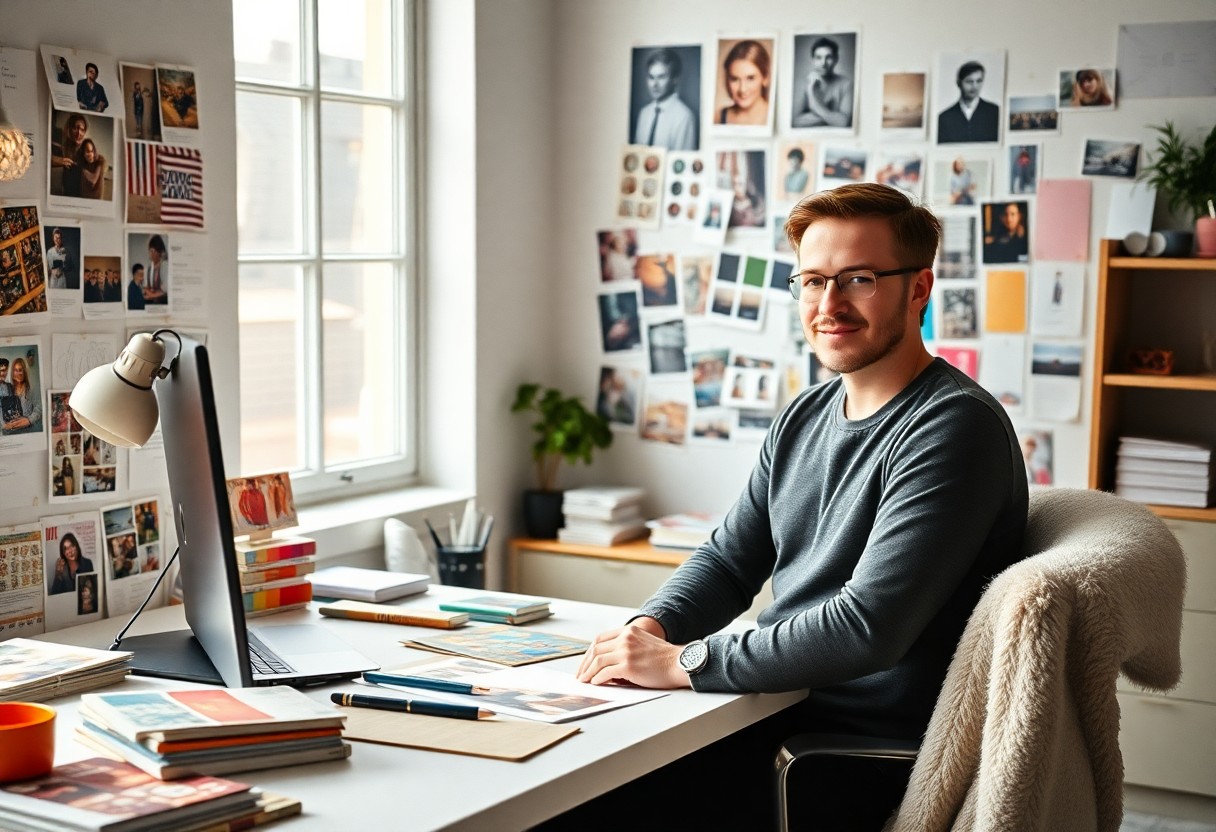It’s fascinating to explore how Jesper Jacobi harnesses the power of Pinterest boards to create stunning mood boards that inspire creativity. In my experience, transforming visual ideas into cohesive designs can elevate your projects significantly. By leveraging Pinterest’s extensive visual database, you can curate images that resonate with your vision. I’ll share the techniques Jesper employs to ensure that each mood board not only reflects personal style but also effectively communicates your intended atmosphere and emotion, helping you achieve your project goals with clarity and confidence.
The Evolution of Mood Boards in Digital Design
Historical Context of Mood Boards
Mood boards have been an integral part of the creative process since the early days of design, originating as physical collages used by artists and designers to visualize concepts and evoke emotions. Traditionally composed of fabric swatches, sketches, and color samples, these boards offered a tactile way to communicate ideas and set the tone for projects. Over time, as design practices evolved, the transition from physical to digital mood boards gained momentum, paralleling the rise of technology and the increasing need for collaboration in creative industries.
The Role of Pinterest in Modern Visual Culture
Pinterest has transformed the way designers, artists, and everyday users curate inspiration and ideas. This platform enables a democratization of creativity by allowing anyone to create visual collections from a vast pool of content. By pinning images, videos, and articles, users can quickly assemble mood boards that reflect their aesthetic preferences and project requirements. The social nature of Pinterest fosters collaboration and sharing, making it an invaluable tool for professional designers and hobbyists alike to inspire and refine their creative visions.
The sheer scope of Pinterest’s influence is staggering, with over 450 million active users each month searching for inspiration across countless categories. Whether you’re a graphic designer looking for typography ideas or a fashion enthusiast pinning outfit inspirations, the platform’s search capabilities make it incredibly easy to discover visual content that resonates with your personal or professional projects. By turning your Pinterest boards into mood boards, you leverage this vast resource to streamline your creative process, ensuring that your vision is not only well-defined but also deeply influential in your design work.
Jesper Jacobi’s Unique Approach to Pinterest
Jesper Jacobi redefines the conventional use of Pinterest by merging visual storytelling with mood board creation. Instead of merely pinning random images, he meticulously *selects each piece to encapsulate specific emotions* and themes. By focusing on *curation through personal experiences and aesthetic preferences*, Jesper crafts unique narratives that resonate strongly with his audience. His approach results in boards that not only showcase beautiful visuals but also convey feelings and inspirations, transforming the way we interact with digital content.
Curating Content: The Art of Selection
Each image pinned by Jesper is a deliberate choice, crafted to mirror a cohesive vision. He emphasizes selecting visuals that evoke *strong emotions*, aligning with the intended mood of the board. The process often involves exploring various categories and styles, from vintage aesthetics to minimalist designs, ensuring that every piece holds relevance and contributes to the overall theme. This selective process draws the viewer into a unified narrative.
Transforming Pixels: Techniques for Crafting Aesthetic Cohesion
Achieving *aesthetic cohesion* in Jesper’s mood boards requires deft manipulation of color, texture, and style across all elements. He starts by establishing a color palette, often inspired by *nature, art, or personal experiences*, which serves as a foundation for every pin. By choosing images that fit this palette or complement it, he ensures a seamless flow of visuals that resonate together, *creating a harmonious visual language.* Subtle transitions, visual rhythms, and attention to detail empower his boards to tell captivating stories.
For instance, he might begin with a warm, earthy color palette that evokes a cozy autumn atmosphere. From there, Jesper strategically selects images that feature these tones, such as rustic interiors, golden foliage, and warm textiles. Layers of texture—like the softness of a wool blanket or the grain of vintage wood—further enhance this feeling of cohesion. The result is a mood board that not only looks visually appealing but also engages your senses, transporting you to that autumn landscape he expertly captures. By weaving together these elements, I find that the mood boards resonate more deeply, engaging viewers and inviting them into a well-crafted visual experience.
Crafting Narrative Through Visuals
Every mood board I create serves as a visual narrative, weaving together disparate elements into a cohesive story. Each pin on my Pinterest board contributes a unique thread that speaks to the emotions or themes I wish to evoke. By carefully selecting images that resonate with a particular vision, I create an atmosphere that invites viewers into a narrative world brimming with possibility, whether it’s a cozy living room or an adventurous outdoor escape.
Storytelling Elements in Mood Boards
When crafting a mood board, I focus on key storytelling elements such as tone, character, and setting. Each visual component plays a role, from the soft lighting that sets a serene mood to the bold textures that suggest adventure. Layering these elements adds depth, allowing viewers to engage their imaginations and draw connections between the visuals, ultimately forming a story that is unique to each interpreter.
The Psychological Impact of Colors and Images
Colors and images wield powerful psychological influences that affect how we perceive the world. In mood boards, warm tones evoke feelings of comfort while cool hues can inspire calmness or introspection. The choice of images also matters; for instance, a picture of a busy café might energize you, while a serene landscape can instill tranquility. By understanding these nuances, I tailor my mood boards to elicit specific emotional responses.
Research has shown that color can evoke distinct feelings even across different cultures. For example, red often symbolizes love or urgency, while blue is frequently associated with trust and peace. I strategically use these color palettes in my mood boards to evoke desired reactions. Similarly, imagery that features people often makes the viewer feel a personal connection, while abstract visuals can provoke thought. Each choice I make is intentional, ensuring that every aspect of the board resonates and contributes to the overarching narrative I’m sharing.
Practical Steps: Building Your Own Mood Board
Creating a mood board can be both enjoyable and beneficial for visualizing your style. Begin by pinning images, colors, and layouts that resonate with your personal taste and project goals. We’ll explore how to organize your Pinterest boards effectively while ensuring they inspire and reflect your unique aesthetic.
Step-by-Step Guide to Pinterest Board Creation
| Step | Description |
|---|---|
| 1. Define Your Theme | Select a clear idea or concept that will guide your board. |
| 2. Create a New Board | On Pinterest, click “Create Board” and assign it a name related to your theme. |
| 3. Start Pinning | Search for images, colors, or quotes that align with your theme and add them to your board. |
| 4. Organize Your Pins | Group similar items together to create a cohesive visual portrayal. |
| 5. Review Regularly | Update your board by removing pins that no longer fit and adding new inspiration. |
Integrating Personal Style and Purpose
Your mood board should be a reflection of your individual style and the intentions behind your project. Think about what motivates your choices—be it your favorite colors, textures, or the mood you wish to evoke. Each element should contribute thoughtfully to the overall aesthetic, aligning with the goals of your project.
When I integrate personal style into my mood boards, I consider my favorite design elements, be it minimalism, bold patterns, or rustic textures. This allows me to convey a sense of who I am while ensuring that each selection serves a purpose. For instance, if I’m designing a space meant for relaxation, calming colors and soft shapes become the foundation of my board. Aligning visual components with the intended emotional response can create a more powerful and cohesive overall design, making the project feel authentically “me.”
The Power of Community in Inspiration
Inspiration thrives in a vibrant community. By surrounding myself with fellow creatives, I harness diverse perspectives that spark fresh ideas. Engaging with others allows me to explore themes and concepts that I may not have considered on my own, ultimately enriching my mood board creations. The symbiotic relationship within these communities fosters an environment where originality flourishes, making it easier to emerge from creative blocks.
Collaborating with Other Creatives
Collaborating with other creatives amplifies the impact of my mood boards. Teaming up allows for a shared exploration of themes and visuals, resulting in a richer tapestry of ideas. When I partner with photographers, graphic designers, or fellow artists, the synergy often unveils hidden possibilities, guiding us towards unique concepts that resonate with both of our audiences.
Engaging with Followers: Feedback and Iteration
Engaging with my followers provides invaluable feedback that shapes my next creations. Their insights help me understand what resonates most and highlight areas for improvement. By encouraging open dialogue, I build a more interactive atmosphere that enhances my creative process, allowing me to iterate on ideas that excite my community.
Feedback can range from simple likes and comments to in-depth discussions on specific elements of my mood boards. For instance, after posting a recent board, I was thrilled to receive a note from a follower who suggested a color palette I hadn’t considered. Implementing this suggestion not only elevated my work but also deepened my connection with my audience. Leveraging their input transforms my mood boards into collaborative stories where we’re all contributors, making the creative journey feel shared and collectively meaningful.
Final Thoughts on Mood Boards as a Creative Tool
The Freedom to Explore
Mood boards provide the freedom to explore and experiment with your creative vision. I’ve found that they can be a reflection of your journey, capturing the essence of multiple inspirations. Locking elements together visually offers clarity that words often cannot convey. They serve as a tangible reminder of your evolving ideas and can even spur new directions. Think of your mood board as a conversation starter with your future self, urging you to think outside the box. By immersing yourself in a curated collection of images, colors, and textures, you unlock opportunities for innovation that could redefine your projects.
FAQ
Q: What is the process Jesper Jacobi uses to turn Pinterest boards into mood boards?
A: Jesper Jacobi starts by curating a selection of images and ideas from various Pinterest boards that align with his vision for a project. He assesses the color palette, shapes, and styles present in these selections, then organizes them in a visually appealing layout. Jacobi often utilizes graphic design tools to enhance the overall aesthetic of the mood board, ensuring that it effectively communicates the intended atmosphere or emotion for the project.
Q: Why are mood boards important in design and creative processes?
A: Mood boards serve as a visual guide that encapsulates the themes, colors, and feelings associated with a project. They help to unify a creative vision and serve as a reference point for designers and collaborators, ensuring that everyone involved is aligned with the concept. Mood boards can also inspire creativity and foster brainstorming sessions, making them an invaluable tool in the early stages of design work.
Q: How does Jesper Jacobi choose images for his mood boards on Pinterest?
A: Jesper Jacobi selects images based on how well they resonate with the project’s theme or emotional intent. He looks for visuals that evoke the specific feelings he aims to convey and emphasizes a cohesive color palette. Jacobi also pays attention to trends and styles that may complement his vision while ensuring that the chosen images are diverse enough to present a well-rounded perspective.
Q: Can anyone create mood boards like Jesper Jacobi, or is it a skill that takes time to develop?
A: While creating mood boards can be learned by anyone, Jesper Jacobi’s expertise comes from experience and a deep understanding of design principles. However, anyone can start by practicing selecting images that inspire them and experimenting with layouts. Over time, individuals can develop their unique style and approach to creating mood boards that reflect their own artistic vision.
Q: What tools does Jesper Jacobi recommend for creating digital mood boards from Pinterest?
A: Jesper Jacobi suggests using graphic design tools such as Canva, Adobe Spark, or Photoshop for creating digital mood boards. These platforms offer a user-friendly interface for organizing images, text, and colors, allowing for dynamic layouts. Jacobi often emphasizes the importance of finding a tool that matches one’s comfort level and enhances creativity during the mood board creation process.




